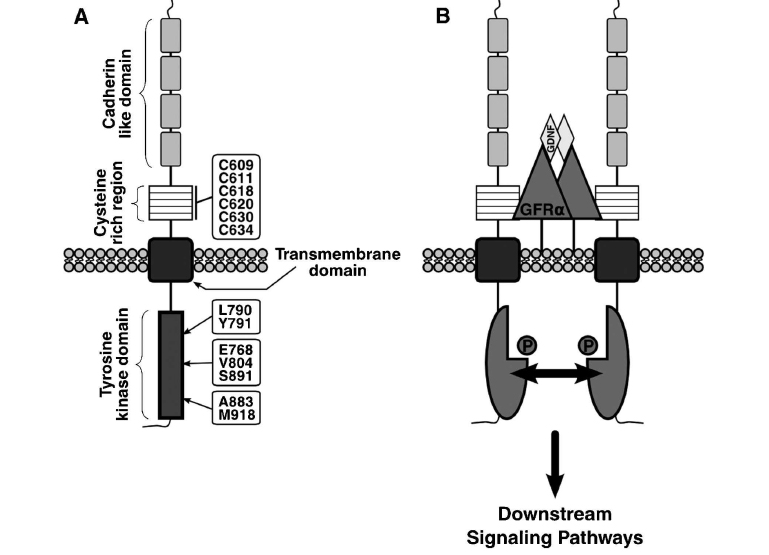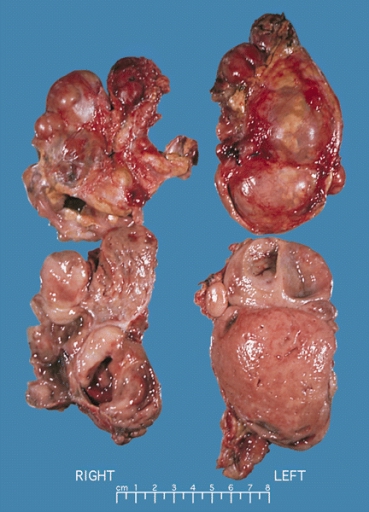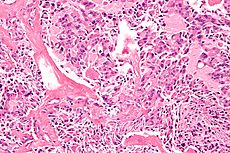Multiple endocrine neoplasia type 2 pathophysiology: Difference between revisions
Jump to navigation
Jump to search
No edit summary |
|||
| Line 29: | Line 29: | ||
! style="background: #4479BA; width: 550px;" | {{fontcolor|#FFF|Phenotype}} | ! style="background: #4479BA; width: 550px;" | {{fontcolor|#FFF|Phenotype}} | ||
|- | |- | ||
! style="background: #DCDCDC;" rowspan=2 | | ! style="background: #DCDCDC;" rowspan=2 |Extracellular cystine rich location | ||
! style="background: #F5F5F5;" | | |||
:c609 | :c609 | ||
:c611 | :c611 | ||
| Line 35: | Line 36: | ||
:c620 | :c620 | ||
:c630 | :c630 | ||
! style="background: #F5F5F5;" | | ! style="background: #F5F5F5;" |Helps to form teritiary structure with the help of disulfide bonds | ||
! style="background: #F5F5F5;" | | ! style="background: #F5F5F5;" |Alteration in protein folding and maturation | ||
! style="background: #F5F5F5;" |MEN 2A and FMTC | |||
|} | |} | ||
| Line 48: | Line 50: | ||
===RET Activation=== | ===RET Activation=== | ||
* Dimerization of RET gene mediated through formation of multicomponent complex. RET is activated by binding both a soluable ligand and a a non signaling extracellular co-receptor. RET activation leads to phosphorylation of multiple intracellular tyrosine kinase. | * Dimerization of RET gene mediated through formation of multicomponent complex. RET is activated by binding both a soluable ligand and a a non signaling extracellular co-receptor. RET activation leads to phosphorylation of multiple intracellular tyrosine kinase. | ||
==Associated Conditions== | ==Associated Conditions== | ||
==Gross Pathology== | ==Gross Pathology== | ||
Revision as of 17:42, 21 September 2015
|
Multiple endocrine neoplasia type 2 Microchapters |
|
Differentiating Multiple endocrine neoplasia type 2 from other Diseases |
|---|
|
Diagnosis |
|
Treatment |
|
Multiple endocrine neoplasia type 2 pathophysiology On the Web |
|
American Roentgen Ray Society Images of Multiple endocrine neoplasia type 2 pathophysiology |
|
Multiple endocrine neoplasia type 2 pathophysiology in the news |
|
Blogs on Multiple endocrine neoplasia type 2 pathophysiology |
|
Directions to Hospitals Treating Multiple endocrine neoplasia type 2 |
|
Risk calculators and risk factors for Multiple endocrine neoplasia type 2 pathophysiology |
Editor-In-Chief: C. Michael Gibson, M.S., M.D. [1]; Associate Editor(s)-in-Chief: Ammu Susheela, M.D. [2]
Overview
Pathogenesis
- The common feature among the three sub-types of MEN2 is a high propensity to develop medullary thyroid carcinoma.
Multiple endocrine neoplasia type 2A
- Multiple endocrine neoplasia type 2 (MEN2) (also known as "Pheochromocytoma and amyloid producing medullary thyroid carcinoma",[1] "PTC syndrome,"[1] and "Sipple syndrome"[1]) is a group of medical disorders associated with tumors of the endocrine system.
- They generally occur in endocrine organs (e.g. thyroid, parathyroid, and adrenals), but may also occur in endocrine tissues of organs not classically thought of as endocrine.[2]
- In MEN2A primary hyperparathyroidism occurs in only 10–30% and is usually diagnosed after the third decade of life. It can occur in children but this is rare. It may be the sole clinical manifestation of this syndrome but this is unusual.
- MEN2A associates medullary thyroid carcinoma with pheochromocytoma in about 20–50% of cases and with primary hyperparathyroidism in 5–20% of cases.
- In familial isolated medullary thyroid carcinoma the other components of the disease are absent.
Multiple Endocrine Neoplasia type 2B
- Multiple endocrine neoplasia type 2B (also known as MEN2B, Mucosal neuromata with endocrine tumors, Multiple endocrine neoplasia type 3, and Wagenmann–Froboese syndrome[1]) is a genetic disease that causes multiple tumors on the mouth, eyes, and endocrine glands. It is the most severe type of multiple endocrine neoplasia,[3] differentiated by the presence of benign oral and submucosal tumors in addition to endocrine malignancies.
- MEN2B associates medullary thyroid carcinoma with pheochromocytoma in 50% of cases, with marfanoid habitus and with mucosal and digestive neurofibromatosis.
Genetics
- Most cases of MEN2 derive from a variation in the RET proto-oncogene, and are specific for cells of neural crest origin.
- The protein produced by the RET gene plays an important role in the TGF-beta (transforming growth factor beta) signaling system. Because the TGF-beta system operates in nervous tissues throughout the body, variations in the RET gene can have effects in nervous tissues throughout the body.
- The RET protooncogene is a 21-exon gene and encodes for a tyrosine kinase transmembrane receptor located on chromosome 10q11.2.[4]
- Four different ligands have so far been recognized: the glial cell-line derived neutrophilic factor (GDNF), neurturin (NTN), persepin (PNS) and artemin (ART). The interaction is mediated by a ligand-specific coreceptor (e.g., the GFRα-1 is the co-receptor for the GDNF).
- The receptor is composed of an extracellular domain (EC), with a distal cadherin-like region and a juxtamembrane cystein-rich region, a transmembrane domain (TM) and an intracellular domain with tyroisine-kinase activity (TK).
| Mutation location | RET codons | Function of wild type codon | Mutated effects | Phenotype |
|---|---|---|---|---|
| Extracellular cystine rich location |
|
Helps to form teritiary structure with the help of disulfide bonds | Alteration in protein folding and maturation | MEN 2A and FMTC |
- MEN2 generally results from a gain-of-function variant of a RET gene. Other diseases, such as Hirschsprung disease, result from loss-of-function variants.
- When inherited, multiple endocrine neoplasia type 2 is transmitted in an autosomal dominant pattern, which means affected people have one affected parent, and possibly-affected siblings and children. Some cases, however, result from spontaneous new mutations in the RET gene. These cases occur in people with no family history of the disorder. In MEN2B, for example, about half of all cases arise as spontaneous new mutations.
- Activating germline point mutations of the RET proto-oncogene are causative events in MEN 2A, MEN 2B, and FMTC. RET mutations have been found to be widely distributed not only among the 5 cysteine codons 609, 611, 618, 620, and 634 but also in other noncysteine codons, such as codon 804 in exon 14, codon 883 in exon 15, and others.

RET Activation
- Dimerization of RET gene mediated through formation of multicomponent complex. RET is activated by binding both a soluable ligand and a a non signaling extracellular co-receptor. RET activation leads to phosphorylation of multiple intracellular tyrosine kinase.
Associated Conditions
Gross Pathology

Microscopic Pathology

References
- ↑ 1.0 1.1 1.2 1.3 Rapini, Ronald P.; Bolognia, Jean L.; Jorizzo, Joseph L. (2007). Dermatology: 2-Volume Set. St. Louis: Mosby. ISBN 1-4160-2999-0.
- ↑ Moline J, Eng C. (2011). "Multiple endocrine neoplasia type 2: an overview". Genet Med. 9 (13): 755–64. doi:10.1097/GIM.0b013e318216cc6d. PMID 21552134.
- ↑ Carlson KM, Bracamontes J, Jackson CE, et al. (December 1994). "Parent-of-origin effects in multiple endocrine neoplasia type 2B". Am. J. Hum. Genet. 55 (6): 1076–82. PMC 1918453. PMID 7977365.
- ↑ Schmoldt A, Benthe HF, Haberland G (1975). "Digitoxin metabolism by rat liver microsomes". Biochem Pharmacol. 24 (17): 1639–41. PMID http://dx.doi.org/10.1155/2012/705036 Check
|pmid=value (help).